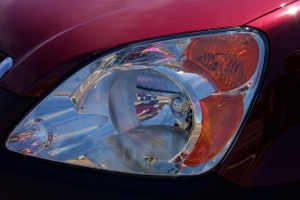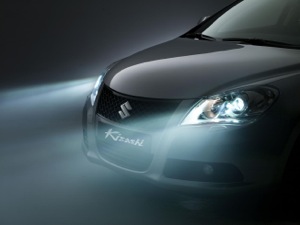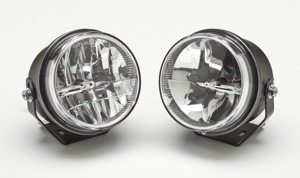Nighttime driving obviously requires a good set of functioning headlights. Headlights should illuminate the road ahead, but not hinder the vision of oncoming drivers. Excessive light and glare from a vehicle’s headlights can be dangerous because it may blind other drivers. 
The Department of Transportation (DOT) has rules that limit not only the brightness of low-beam and high-beam headlamps for on-road use, but also dictate how the headlights project their light. The light pattern from low-beam headlights should cut off roughly at hood level, and not scatter too far into the oncoming lane of traffic.
The headlight beam pattern of any given vehicle is determined by the design of the reflector inside the headlamp housing, the headlamp lens (if one is used to further direct and diffuse the light), and the location of the bulb inside the housing. Since all of these are fixed by the vehicle manufacturer, the only component that can easily be modified to enhance lighting performance is the headlamp bulb.
Halogen Headlamps
Halogen headlamps have been around since the 1970s, when a change in federal regulations allowed vehicle manufacturers to use “composite” headlight housings instead of sealed beam headlamps. Composite housings allowed greater styling freedom in the design of the headlight itself for better optics and aerodynamics. It also allowed the use of replaceable bulbs that could be changed from the rear of the housing. In theory, this simplified replacement by eliminating the need to remove lens covers, grille trim and retaining rings to change a burned-out headlamp. But on some vehicles, there’s not much clearance behind the headlight assembly, so replacing a bulb can be difficult.
The switch to halogen headlamps provided a significant improvement in lighting. On older vehicles with sealed-beam headlamps, light output was limited not only by DOT rules, but also by the poor efficiency of the bulb itself.
One of the limitations of conventional headlamps is that their light output depends on the temperature of the filament. The hotter the filament, the brighter it glows and the more light it produces. But if the filament runs too hot, it will quickly burn out and fail.
Tungsten wire is used for the filament in most incandescent light bulbs because it has a melting temperature of 6,332F (3,500C). It can burn fairly hot for a long time without burning out, as long as there is no oxygen inside the bulb. So the air inside the bulb is removed and replaced with inert argon gas to cool the filament. This works fairly well, but over time some of the tungsten vaporizes from the hot filament and forms a black coating on the inside of the bulb. This slowly reduces the light output of the bulb as it ages. Eventually, the filament thins to the point where it either fails or breaks.
With halogen lighting, argon is replaced with a mixture of bromine, chlorine and fluorine, allowing the filament to run hotter and produce more light without burning out.
The iodine gas inside the bulb helps recirculate the hot metal vapor so it re-deposits back on the filament, prolonging the life of the bulb. The gas pressure inside the bulb also is about three to four times higher than a standard bulb to further reduce metal evaporation from the hot filament. As a result, the glass on a halogen bulb doesn’t darken as the bulb ages, and light output remains much more consistent throughout the life of the headlamp. But the higher operating temperature of a halogen headlamp does require a special heat-resistant quartz glass.
The higher operating temperature of a halogen headlamp also means it operates more efficiently, producing more light with less power consumption. A halogen low-beam headlamp that uses 55 watts may produce 1,000 to 1,400 lumens of light depending on the lamp number, while a 65-watt high-beam halogen headlamp may produce 1,270 to 1,700 lumens.
Another plus with halogen headlamps is that the color of the light is whiter and closer to natural daylight than that produced by conventional incandescent bulbs. The color of the light produced by a headlamp is often referred to as its “temperature” in degrees Kelvin (K). This can be a bit confusing because it has nothing to do with how hot the bulb is, but rather the spectrum of light it is producing. The higher the temperature rating of the bulb, the bluer the light it produces appears to the human eye.
Halogen headlamps typically produce light with a temperature (color) rating of about 3,100K to 3,500K, depending on the bulb. A conventional incandescent sealed beam headlamp, by comparison, produces light with a temperature rating of around 2,800K, giving it a slightly yellowish appearance.
Whiter light reflects better off objects and road signs at night, improving visibility for safer nighttime driving.
HID Lighting
In the mid-1990s, the first high intensity discharge (HID) headlight systems appeared on European sports sedans and domestic luxury cars. Since then, the use of HID lighting has grown substantially, with hundreds of models now offering it either as standard equipment or an extra cost option.
Unlike conventional or halogen headlamps, HID headlights use bulbs that do not have a wire filament. Instead, they contain a mixture of xenon, other gases and mercury vapor (which was discontinued in 2004 in new bulbs, but is still present in older HID bulbs).
When the gas inside the bulb is excited with high voltage (20,000 to 25,000 volts), xenon becomes conductive. This initiates an arc that starts the bulb glowing. Within a couple of seconds, the bulb comes up to full brightness. The voltage needed to sustain the arc can then be reduced to about 9,000 to 15,000 volts, where it remains until the HID headlamps are switched off. Since there is no filament to burn out or break, bulb life is up to 10 times that of a halogen headlamp.
The light produced by a xenon HID headlamp also is much higher than a halogen headlamp (up to three times greater). Though the voltage required also is higher, the wattage (current) needed to power HID headlights is actually less, typically around 35 watts. This reduces the load on the alternator, helping to improve fuel economy when driving with the headlights on.
The light produced by HID xenon headlamps is about 14% ultraviolet, which is filtered but still gives the headlamps a slightly bluish cast. The color rating on most OE HID headlamps is around 4,200K. The slightly bluish white light is even better than the white light produced by halogen bulbs for visual clarity and depth perception when driving at night. But some motorists say the bluish-white glare produced by HID headlights is too bright and too distracting.
Even so, some people who own older vehicles or even newer ones with standard halogen lighting want the look and performance of HID headlights. OE HID lighting can add considerable cost to a vehicle, up to $1,200 or more depending on the make and model. Aftermarket HID conversion kits are available for converting vehicles, and may cost as little as $200 (though some kits can run up to $1,000 or more for certain applications).
HID headlights require a high-voltage ballast and control module to start and control the voltage to the headlamps. The HID bulb often is referred to as an “igniter” because of the way it works. On older-style HID headlamps, such as D1S and D1R bulbs, the ballast is built into the base of the bulb assembly (making them very expensive to replace). HID bulbs such as D2S and D2R use an external ballast, making them less expensive, but still more costly than halogen bulbs to replace.
One way to tell if a vehicle is equipped with HID headlamps is to look at the outer lens cover. If the headlamps are HID, the markings D1R, D1S, D2R or D2S will be displayed on the lens.
Xenon HID bulbs do run hot (up to 1,500F) and contain up to 30 atmospheres of internal pressure. This creates a potential burn and explosion hazard, so voltage should never be connected to a HID bulb outside of the headlamp assembly to test it. Also, the HID bulb must be in a horizontal position when it is on, otherwise it may overheat and fail.
The End of the Road
Halogen bulbs typically last 400 to 600 hours, which roughly translates into 25,000 to 40,000 miles of nighttime driving. Since most vehicles are driven both during the day and night, it’s hard to say how long the original headlamps will last before they burn out. Driving on rough roads also can shorten the normal lifespan of the headlamps because the filaments are vulnerable to jolts and vibrations. Also, any problems with a vehicle’s battery or charging system that result in a higher than normal charging voltage over a period of time can lead to premature headlamp failure.
When a headlamp eventually fails, it creates a potential safety hazard for the motorist, other vehicles and pedestrians. With one of the headlamps burned out, the total light output of the headlights is cut in half. It’s usually one of the low beams that fails because the low beams get the most use.
When a headlamp burns out, therefore, it creates an immediate replacement opportunity – and a potential upgrade opportunity.
Standard replacement halogen bulbs typically sell for $6 to $10 each, depending on how they are packaged and the application. There’s not a lot of profit in selling individual replacement bulbs to customers one at a time, so bulbs often are packaged in twin-packs. This accomplishes two things: it increases the total price of the sale, and it ensures the sale of the second bulb without having to wait for the other bulb to fail.
When one headlamp fails, its companion on the other side is likely near the end of the road, too, since both have had the same number of hours of use. Selling your customer a twin-pack provides a spare bulb so the other bulb can be replaced when it fails. Or, the customer can change both bulbs at the same time while it is convenient to do so, and not have to worry about replacing headlamps for another 400 to 600 hours of nighttime driving.
One tip to pass along to techs is to use care when replacing halogen headlamps. Do NOT touch the glass with bare fingers. The oil from a fingerprint can form a hot spot on the glass that can make the bulb crack and fail very quickly. The bulb should be handled by its base only while it is being installed.
If replacing an HID headlamp, techs should make sure power to the headlamps is off to avoid a high-voltage shock. Disconnecting a battery cable temporarily is a good idea here.
| Selling Lighting Upgrades Add-on auxiliary driving and fog lamp sales can add value to your customers’ driving experience, as well as your dealership’s bottom line.According to Rodger Wagner, executive vice president of PIAA Corp., newinnovations in light-emitting diode (LED) technology provide terrific illumination with very little current draw.  “LED driving and fog lamps can be installed quickly and easily, without the need for relays or complex wiring schemes,” he said. ”All that’s needed is a 12-volt power source and a simple on-off switch. LEDs are rugged and, unlike halogen and high intensity discharge (HID) bulbs, practically never fail.” The newest-generation LED fog and driving lamps use unique reflector facing technology (RFT) and feature bright LED bulbs that actually face rearward. A computer-designed multi-surface reflector is used to redirect the intensified LED light forward, toward the road ahead. “Thisexclusive RFT technology provides much better beam control than you might expect to find in other fog and driving lamps,” Wagner said. Target customers for auxiliary lighting upgrades include owners of sportcompact or sporty cars (BMWs, Audis, Minis and Subarus); owners of trucks and SUVs who may want an “off-roading” look; and older drivers who may have trouble driving at night, he added. For information on light patterns, installation and aiming, visit piaa.com. |
Lighting Upgrades
For people who do a lot of driving after dark and replace headlamps often, upgrading to “long-life” replacement headlamps that have more durable filaments is recommended. Long-life bulbs cost a little more than standard bulbs, but provide significantly longer service life, which saves money in the long run.
Many aftermarket suppliers also offer upgrade headlamps for increased light output, along with a bluer HID type of appearance. Some of these bulbs use a blue tint on the glass to achieve a more bluish white light, while others contain xenon gas that allows the bulb to burn hotter so it can produce more light. Xenon bulbs still have a filament like a regular halogen bulb, so don’t confuse them with true HID bulbs that do not contain a filament. And no, you can’t substitute a true HID bulb for an ordinary halogen bulb because of the voltage difference.
Upgrade replacement headlamps that claim a higher light output usually have a higher wattage rating. This can reduce bulb life (as much as 50% in some cases!), while also increasing the load on the electrical circuit and charging system.
Upgrade headlamps are available in various temperature (color) ratings. Bulbs rated at 5,000K to 8,000K have a bluer appearance than standard halogen headlamps. Bulbs rated 10,000K to 12,000K have a very blue appearance. Bulbs rated from 15,000K to 30,000K generate a purplish light.
There’s no visibility advantage in going to the extremely high-temperature ratings. The color shift beyond bluish-white is more for cosmetics and customization.
Upgrade performance headlamps that feature increased light output and/or a bluish tint typically sell in the $18 to $26 range for a twin-pack, making them a more profitable item to sell than standard replacement bulbs. Better yet, they can be sold anytime to almost any customer who might be interested in upgrading or customizing the headlights on their vehicle.













